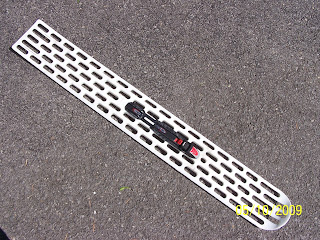Descending on skishoes
One of the most common questions we get about Trackers Skishoes is how do you take them down hills. Can you turn them? Generally, no; most descents are done in straight-ahead fashion without making turns - in fact, we've dubbed it straight-line skiing. In almost all conditions, the width of the skishoes combined with the gliding crampons will slow you on descents and give you more stability as compared with cross-country skiing. This is especially true with crusty snow and powder. Generally, the harder the snow, the more the crampons will slow you, as they actually saw through ice and crust. Powder is inherently slow, so you'll float through that. Many of us dream of skiing in knee-deep powder at downhill ski resorts and live for powder days. Straight-line skiing through powder on skishoes gives you a similar thrill, so now you can dream of that.
Five different scenarios exist, depending on the steepness of the terrain and snow conditions. For moderate conditions, which usually covers most of the terrain, you can continue with the standard kick-and-glide technique you use on level ground. When it gets a little steeper, you can just keep the skishoes parallel and even with each other and coast straight down the slope. If it gets even steeper, and you feel a little out of control with this, you can shift the skishoes back and forth in a scissors maneuver like telemark skiers use. Combined with the width of the skishoes, the broader base gives you more stability, and shifting them back and forth slows you. Sitting back and flexing your knees to stay low as you do this makes you even more stable. For even steeper slopes, you can use some of the same techniques you would for cross-country skiing, such as snowplowing and step turns. You can also drag and plant your poles to control speed. Lastly, for long, steep descents, you can attach our removable crampons to the bottoms of your skishoes, effectively turning them into snowshoes.
Five different scenarios exist, depending on the steepness of the terrain and snow conditions. For moderate conditions, which usually covers most of the terrain, you can continue with the standard kick-and-glide technique you use on level ground. When it gets a little steeper, you can just keep the skishoes parallel and even with each other and coast straight down the slope. If it gets even steeper, and you feel a little out of control with this, you can shift the skishoes back and forth in a scissors maneuver like telemark skiers use. Combined with the width of the skishoes, the broader base gives you more stability, and shifting them back and forth slows you. Sitting back and flexing your knees to stay low as you do this makes you even more stable. For even steeper slopes, you can use some of the same techniques you would for cross-country skiing, such as snowplowing and step turns. You can also drag and plant your poles to control speed. Lastly, for long, steep descents, you can attach our removable crampons to the bottoms of your skishoes, effectively turning them into snowshoes.
Tom Gibson
The Skishoe Guy
Trackers Skishoes
www.TrackerSkishoes.com



How do you turn if there is a curve in the hill you are descending? I have trails with sharp turns that are really fun on xc skis but you must know how to edge to do this. Can you edge with these?
ReplyDelete